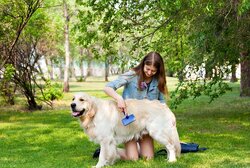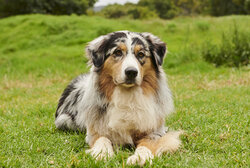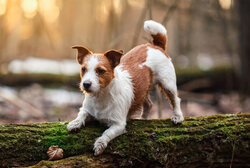Fleas in dogs
There is always a risk that dogs will catch fleas when the weather is warm. An owner wishing to spare their pet from these bloodsuckers, should take precautionary measures. Read our best tips about fleas in dogs.
Practically every dog will catch fleas sooner or later, whether through contact with other dogs or out wandering in the garden or park. Generally it is only animals that live exclusively indoors which are spared - as well as pets whose owners have protected them in good time. To this end, a range of very well tolerated and effective preparations are meanwhile available from vets. Products which prevent development, for example, stop a dog from becoming infested by fleas in the first place - providing the products are applied in good time and on a regular basis. Generally the flea treatment is mixed into food once a month from the start of the season. It takes effect by preventing any fleas the dog has caught from multiplying.
How does a flea infestation manifest itself in dogs?
Fleas feed on the blood of our four-legged friends. But what are the signs that your dog may have fleas?
- Frequent scratching caused by severe itching can be an indication that your dog has fleas
- The dog licks its fur noticeably often
- The dog bites its fur
It is also possible that your dog has a flea allergy. If this is the case, your four-legged friend is reacting to the saliva of the parasites.
How can I tell if my dog has fleas?
To determine whether your dog has fleas, you should thoroughly examine its coat and the surface of its skin. In many cases it is clear that a dog already has fleas as flea excrement can be seen in the fur. You can check this yourself: place the dog on a piece of white paper or in the bathtub and comb it with a flea comb. Dampen the dark grains that fall to the ground with water. Alternatively, you can let these grains fall onto a dampened sheet of kitchen roll in order to identify fleas on your dog. If these are flea excrement, red streaks will appear as flea excrement contains blood.
In such a case, a so-called adulticide should be used. This is a type of treatment which quickly kills off the fleas on a sustained basis. It needs to be applied once a month, generally in the form of a solution which is trickled onto the skin of the dog. If an infestation of fleas is suspected, this treatment should be started without delay.
Treating a flea infestation on your foor-legged friend
The longer the dog has already been infested by fleas, the greater the chance that there are also eggs and larvae in the fur. Moreover, less than 10% of fleas live on the animal - the rest are found in the environment especially in areas where the animal often sleeps or lies. These areas should always be treated at the same time by cleaning and vacuuming thoroughly. To permanently prevent fleas in dogs, a development preventer can be used during and after treatment with an adulticide. It is best to consult your vet about which options make most sense in your specific case.
You should never try to use garlic or similar remedies. Studies have shown such ‘natural’ preparations, at best, are ineffective. Sometimes they can actually cause harm. This is the case with tea tree oil, for example, which is quite frequently incorrectly recommended for animals.
You may also like this

When a dog keeps scratching itself
Scratching can be an indication of parasites or an allergy

Moulting in dogs
How to help your dog during moulting

Allergies in dogs
Common allergies and treatment options

Lyme disease in dogs
Ticks can cause a number of infectious diseases

